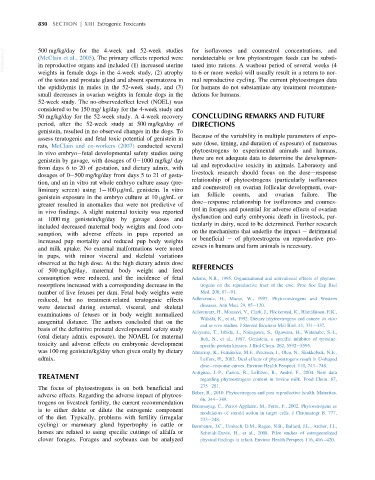Page 872 - Veterinary Toxicology, Basic and Clinical Principles, 3rd Edition
P. 872
830 SECTION | XIII Estrogenic Toxicants
VetBooks.ir 500 mg/kg/day for the 4-week and 52-week studies for isoflavones and coumestrol concentrations, and
nondetectable or low phytoestrogen feeds can be substi-
(McClain et al., 2005). The primary effects reported were
tuted into rations. A washout period of several weeks (4
in reproductive organs and included (1) increased uterine
weights in female dogs in the 4-week study, (2) atrophy to 6 or more weeks) will usually result in a return to nor-
of the testes and prostate gland and absent spermatozoa in mal reproductive cycling. The current phytoestrogen data
the epididymis in males in the 52-week study, and (3) for humans do not substantiate any treatment recommen-
small decreases in ovarian weights in female dogs in the dations for humans.
52-week study. The no-observedeffect level (NOEL) was
considered to be 150 mg/ kg/day for the 4-week study and
50 mg/kg/day for the 52-week study. A 4-week recovery CONCLUDING REMARKS AND FUTURE
period, after the 52-week study at 500 mg/kg/day of DIRECTIONS
genistein, resulted in no observed changes in the dogs. To
Because of the variability in multiple parameters of expo-
assess teratogenic and fetal toxic potential of genistein in
sure (dose, timing, and duration of exposure) of numerous
rats, McClain and co-workers (2007) conducted several
phytoestrogens to experimental animals and humans,
in vivo embryo fetal developmental safety studies using
there are not adequate data to determine the developmen-
genistein by gavage, with dosages of 0 1000 mg/kg/ day
tal and reproductive toxicity in animals. Laboratory and
from days 6 to 20 of gestation, and dietary admix, with
livestock research should focus on the dose response
dosages of 0 500 mg/kg/day from days 5 to 21 of gesta-
relationship of phytoestrogens (particularly isoflavones
tion, and an in vitro rat whole embryo culture assay (pre-
and coumestrol) on ovarian follicular development, ovar-
liminary screen) using 1 100 μg/mL genistein. In vitro
ian follicle counts, and ovarian failure. The
genistein exposure in the embryo culture at 10 μg/mL or
dose response relationship for isoflavones and coumes-
greater resulted in anomalies that were not predictive of
trol in forages and potential for adverse effects of ovarian
in vivo findings. A slight maternal toxicity was reported
dysfunction and early embryonic death in livestock, par-
at 1000 mg genistein/kg/day by gavage doses and
ticularly in dairy, need to be determined. Further research
included decreased maternal body weights and food con-
on the mechanisms that underlie the impact detrimental
sumption, with adverse effects in pups reported as
or beneficial of phytoestrogens on reproductive pro-
increased pup mortality and reduced pup body weights
cesses in humans and farm animals is necessary.
and milk uptake. No external malformations were noted
in pups, with minor visceral and skeletal variations
observed at the high dose. At the high dietary admix dose REFERENCES
of 500 mg/kg/day, maternal body weight and feed
consumption were reduced, and the incidence of fetal Adams, N.R., 1995. Organizational and activational effects of phytoes-
resorptions increased with a corresponding decrease in the trogens on the reproductive tract of the ewe. Proc Soc Exp Biol
number of live fetuses per dam. Fetal body weights were Med. 208, 87 91.
reduced, but no treatment-related teratogenic effects Adlercreutz, H., Mazur, W., 1997. Phyto-oestrogens and Western
were detected during external, visceral, and skeletal diseases. Ann Med. 29, 95 120.
Adlercreutz, H., Mousavi, Y., Clark, J., Ho ¨ckersted, K., Ha ¨ma ¨la ¨inen, E.K.,
examinations of fetuses or in body weight normalized
Wa ¨ha ¨la ¨, K., et al., 1992. Dietary phytoestrogens and cancer: in vitro
anogenital distance. The authors concluded that on the
and in vivo studies. J Steroid Biochem Mol Biol. 41, 331 337.
basis of the definitive prenatal developmental safety study
Akiyama, T., Ishida, J., Nakagawa, S., Ogawara, H., Watanabe, S.-I.,
(oral dietary admix exposure), the NOAEL for maternal
Itoh, N., et al., 1987. Genistein, a specific inhibitor of tyrosine-
toxicity and adverse effects on embryonic development specific protein kinases. J Biol Chem. 262, 5592 5595.
was 100 mg genistein/kg/day when given orally by dietary Almstrup, K., Ferna ´ndez, M.F., Petersen, J., Olea, N., Skakkebæk, N.E.,
admix. Leffers, H., 2002. Dual effects of phytoestrogens result in U-shaped
dose response curves. Environ Health Perspect. 110, 743 748.
Antignac, J.-P., Cariou, R., LeBizec, R., Andre ´, F., 2004. New data
TREATMENT
regarding phytoestrogens content in bovine milk. Food Chem. 87,
The focus of phytoestrogens is on both beneficial and 275 281.
Baber, R., 2010. Phytoestrogens and post reproductive health. Maturitas.
adverse effects. Regarding the adverse impact of phytoes-
66, 344 349.
trogens on livestock fertility, the current recommendation
Benassayag, C., Perrot-Applanat, M., Ferre, F., 2002. Phytoestrogens as
is to either delete or dilute the estrogenic component
modulators of steroid action in target cells. J Chromatogr B. 777,
of the diet. Typically, problems with fertility (irregular 233 248.
cycling) or mammary gland hypertrophy in cattle or Bernbaum, J.C., Umbach, D.M., Ragan, N.B., Ballard, J.L., Archer, J.I.,
horses are related to using specific cuttings of alfalfa or Schmidt-Davis, H., et al., 2008. Pilot studies of estrogenrelated
clover forages. Forages and soybeans can be analyzed physical findings in infant. Environ Health Perspect. 116, 416 420.

